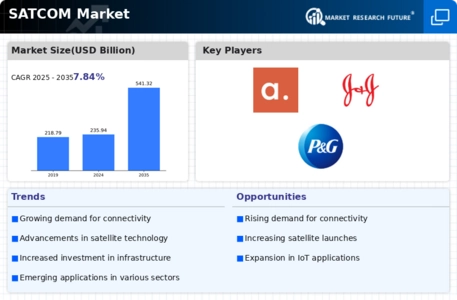Advancements in Satellite Technology
Technological innovations are playing a pivotal role in shaping the SATCOM Market. The development of high-throughput satellites (HTS) and low Earth orbit (LEO) satellite constellations is revolutionizing the way satellite communication is delivered. HTS technology allows for increased bandwidth and improved data transmission rates, catering to the growing demand for high-speed internet services. Furthermore, LEO satellites are expected to provide global coverage with reduced latency, making them particularly appealing for applications such as IoT and mobile communications. As these advancements continue to unfold, they are likely to enhance the competitiveness of the SATCOM Market, attracting new players and investment opportunities.
Emerging Markets and New Applications
Emerging markets are becoming increasingly relevant to the SATCOM Market, as developing regions seek to enhance their communication capabilities. The demand for satellite services in these areas is driven by the need for improved connectivity in sectors such as education, healthcare, and disaster management. Additionally, new applications such as remote sensing and telemedicine are gaining traction, further expanding the market potential. As these regions invest in satellite technology to bridge the digital divide, the SATCOM Market is expected to witness significant growth opportunities. The convergence of emerging markets and innovative applications may redefine the landscape of satellite communication in the coming years.
Rising Adoption of IoT and M2M Communications
The proliferation of Internet of Things (IoT) devices and machine-to-machine (M2M) communications is significantly influencing the SATCOM Market. As industries increasingly integrate IoT solutions for automation and data collection, the need for reliable satellite connectivity becomes paramount. The SATCOM Market is expected to benefit from this trend, with estimates suggesting that the number of connected IoT devices could reach 30 billion by 2030. This surge in connectivity requirements is likely to drive demand for satellite communication solutions, particularly in sectors such as agriculture, transportation, and energy. Consequently, the SATCOM Market is positioned to capitalize on the growing intersection of satellite technology and IoT applications.
Increased Investment in Satellite Infrastructure
Investment in satellite infrastructure is a critical driver for the SATCOM Market. Governments and private entities are recognizing the strategic importance of robust satellite networks to support national security, disaster response, and economic development. Recent initiatives indicate that several countries are allocating substantial budgets to enhance their satellite capabilities, with some nations planning to launch new satellite systems to improve coverage and service quality. This influx of capital is expected to stimulate innovation and competition within the SATCOM Market, leading to improved services and lower costs for end-users. As infrastructure investments continue to rise, the SATCOM Market is likely to experience accelerated growth.
Growing Demand for Satellite Communication Services
The SATCOM Market is experiencing a notable surge in demand for satellite communication services, driven by the increasing need for reliable connectivity across various sectors. Industries such as telecommunications, broadcasting, and defense are increasingly relying on satellite technology to ensure uninterrupted communication. According to recent data, the SATCOM Market is projected to reach a valuation of approximately 100 billion USD by 2026, reflecting a compound annual growth rate of around 6 percent. This growth is largely attributed to the rising adoption of satellite-based internet services, particularly in remote and underserved regions, where traditional infrastructure is lacking. As businesses and governments seek to enhance their communication capabilities, the SATCOM Market is poised for continued expansion.














Leave a Comment